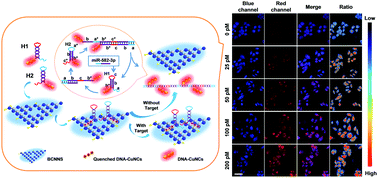g-C3N4 nanosheet-based ratiometric fluorescent probes for the amplification and imaging of miRNA in living cells†
Abstract
Fundamental understanding of microRNA (miRNA) regulated cellular processes requires smart tools capable of imaging the expression and distribution of miRNAs in living cells. However, the low-expression of miRNA and a complex intracellular environment bring great challenges for intracellular miRNA imaging. We found that boron doped g-C3N4 nanosheets (BCNNS) are capable of binding copper nanocluster (CuNC)-labeled hairpin DNA and quench the fluorescence of CuNCs. A turn-on fluorescent sensor for the detection of miR-582-3p in living cells is thus developed based on the affinity change of BCNNS and DNA probes upon their recognition to the target. Ratiometric fluorescence measurement is achieved by taking advantage of the inherent fluorescence emission of BCNNS as the cell interior label. By combining the hybridization chain reaction (HCR) amplification and inherent sensitivity of a turn-on fluorescence sensing strategy, this approach gives rise to a limit of detection (LOD) of 49 fmol L−1 for miR-582-3p, within a linear range of 0.2–1 pmol L−1. The LOD is further improved to 12 fmol L−1 with a correlation to ICP-MS by measuring the 63Cu isotope. With the merits of high sensitivity and selectivity of the HCR and the anti-interfering capability of the ratiometric fluorescent probe, the single cell miR-582-3p expression levels are successfully detected, which indicated that this assay provides a sensitive and enzyme-free approach for miRNA imaging in living cells.



 Please wait while we load your content...
Please wait while we load your content...